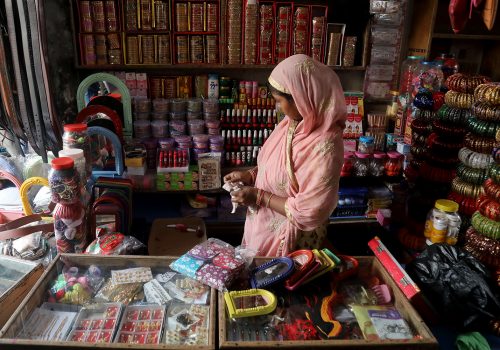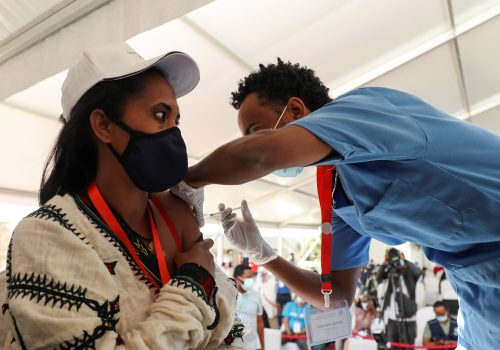IMF delivers fiscal firepower
Today, the International Monetary Fund (IMF) distributed an unprecedented allocation of Special Drawing Rights (SDRs), worth approximately $650 billion USD. Sometimes referred to as liquid gold, this issuance of SDRs is aimed at helping countries fight COVID and invigorate the global economic recovery. This allocation dwarfs the previous record of $250 billion disbursed in 2009 in the aftermath of the global financial crisis and reflects the ability of international leadership from the IMF Board of Governors, as well as new Managing Director Kristalina Georgieva, to broker a deal among the 190 IMF member states.
So what is so special about Special Drawing Rights? SDRs are not a currency per se. Instead, they are a claim on currency created by the IMF in the late 1960s to supplement the supply of easily exchangeable reserve assets. SDRs function as an IOU on an agreed-to basket of currencies: the US dollar, the euro, the Japanese yen, the Chinese yuan, and the British pound. Recipient countries can choose to swap their SDRs for one of these hard currencies. The current value of the SDR to the dollar is 1 Right to $1.416 Dollars.
The IMF is encouraging countries to use this iteration of SDRs to combat the pandemic. For example, countries could draw on SDRs to free up their foreign currency reserves to fund economic stimulus and health spending or retain their allocation to boost resilience against financial volatility. To understand how individual nations will be impacted, explore this map showing each country’s share of the $650 billion.
Hover over a country to see the value of its SDR allocation
However, the allocation will likely be less effective in combating COVID than the $650 billion value may imply. SDRs are allocated in relation to the yearly quota each member nation pays the IMF. The quota is proportional to each country’s GDP, meaning the majority of the funds will be apportioned to the rich nations. Wealthy nations like Switzerland and Norway—which have been relatively unimpacted by COVID—will respectively receive around $900 and $950 per person while some of the worst-affected countries like Bangladesh and the Philippines will respectively receive only around $10 and $25 per person. The IMF has highlighted that around $275 billion of the allocation will support developing economies, with $21 billion of that going to low-income countries. To see the global per capita SDR breakdown, explore the map below.
Many rich nations receiving the largest allocations of SDRs may not need this additional infusion thanks to their own fiscal firepower, and may instead look to channel some of their share to aid countries in need. However, donating SDRs is not as simple as transferring the assets from nation to nation. This is because SDRs are governed by a complex set of rules designed to ensure they operate as a reserve asset for the global economy. Given the intricate regulations controlling reserve assets enforced by both the IMF and many member nations, it is often easier for nations to “loan” out SDRs. During the pandemic, members have lent $15 billion of existing SDRs to support the IMF’s Poverty Reduction and Growth Trust (PRGT), which offers credit to low-income countries at essentially zero interest. The US and other large economies have agreed to try and “recycle” as many SDRs as possible after this new infusion, to ensure those who need help get it.
Though the IMF has 190 members, only 187 will receive their SDRs today. The legitimacy of the governments of Afghanistan, Myanmar, and Venezuela are all contested, which precludes disbursement under the IMF’s rules. Venezuela was blocked from SDRs in 2019 due to disputes over the recognition of the Maduro regime. After the military coup in 2021, Myanmar’s regime has not been recognized by a majority of IMF members.
Afghanistan is a more recent addition to the list of blocked nations. In the wake of the Taliban’s blitz across the country, on August 18 the IMF stated that “a lack of clarity within the international community regarding recognition of a government in Afghanistan” blocked access to its $440 million allocation of SDRs. GeoEconomics Center Director Josh Lipsky wrote an op-ed in the Wall Street Journal explaining the decision, noting the uncertainty over future recognition of the Taliban regime. Nevertheless, international financial institutions must carefully balance the competing imperatives of reducing the Afghan people’s suffering while not legitimizing the Taliban’s repression and grip on power.
A few diplomatically contested countries will still receive SDR allocations. For example Belarus will receive nearly $1 billion in SDRs while Iran will receive close to $5 billion. However, Iran may still have trouble cashing them in due to sanctions restricting their use of SDRs.
While historic, today’s $650 billion allocation is just the beginning. Over the next few months, look out for each country’s plan to put their SDRs to work fighting the pandemic and spurring the global economic recovery.
Niels Graham is a program assistant for the GeoEconomics Center.
William Howlett is a Young Global Professional at the GeoEconomics Center and a rising senior at Stanford studying economics and writing a thesis on ties between US economic and security policy towards China. His interests center around industrial strategy, trade, and currency policy.
Related reading

At the intersection of economics, finance, and foreign policy, the GeoEconomics Center is a translation hub with the goal of helping shape a better global economic future.


